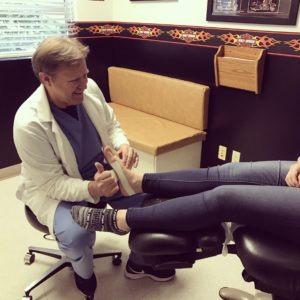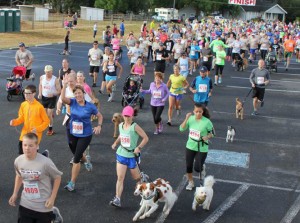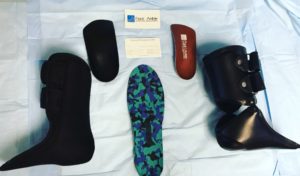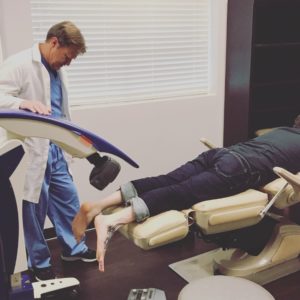
Spring is (finally) here and that means more and more of us are headed outside to exercise. Maybe you’re going out for spring sports, running marathons, or just cleaning up the garden. While these things are great, they can also spell trouble if you have taken the winter off from any physical activity. Dr. Thomas Burghardt a board-certified physician and surgeon at Foot & Ankle Surgical Associates says he sees a lot of new injuries come in during spring. To help us all get active safely, he is sharing the risks as well as some preventive measures to stay sound this spring.
“People haven’t been active for a while and suddenly they want to get in shape for summer,” Dr. Burghardt says. “With the nicer weather, people want to go out and run a marathon. But the problem is they haven’t done any running since last summer. These people are at a higher risk because their bodies are not in shape. We see a lot of overuse injuries in the spring.”

Strains and sprains are common injuries most of us are familiar with and Dr. Burghardt sees a lot of them in the spring. “We see ankle sprains from all the sports – basketball, baseball, soccer – you name it,” he adds. They also see fractures in the ankle, although they are not as common.
Other risks people may not think about are tendonitis and plantar fasciitis. Both of these can be caused by overuse of your tendons and ligaments in your feet, especially when you are not in shape for the activity you are trying to do. “Plantar fasciitis is one of the main things we see very frequently in the spring,” Dr. Burghardt says. “And it’s not just sports injuries, but people just getting busier in general. They go outside and walk. They are mowing their lawns and wearing bad equipment, bad shoes, with not enough support.”
Non-strenuous activities can cause injuries just the same as if you were playing a sport or running a marathon. Even someone who had no desire to actually “workout,” but is spending time mowing the lawn, gardening, or taking the dog for longer walks, may find themselves with foot pain related to overuse.
Kids tend to get sprains and strains more than tendonitis or plantar fasciitis. Little kids can get growth plate injuries as well. For example, a lot of kid soccer players get apophysitis, inflammation of the growth plate in their heel, which causes heel pain.
How To Prevent Injury During Spring Training
So how you make sure your spring time activities aren’t cut short by an injury? Dr. Burghardt has some tips:
#1 – Shoes
Spring and summer are notorious for bad foot wear, which is one of the leading factors in injuries Dr. Burghardt says. If you are mowing your lawn in rubber boots, which have no support, or going for a walk in your flip-flops or flats, you are increasing the chances of a foot injury. “So wear those athletic shoes on your trip to Disneyland,” he adds.
For athletes, it’s important they wear the proper type of shoe. Runners should wear shoes made for running. Baseball players should wear baseball shoes, etc. In addition, they need to inspect last year’s shoes and make sure they are still in good shape. He says that many times injuries happen because someone is wearing a worn out shoe that no longer gives the support and protection it once did. “A runner’s shoes should be replaced about every 500 miles,” he adds. Otherwise, you could end up with an overuse injury.
#2 – Start Slowly
We’ve all been there. The weather has been awful, you haven’t felt like going out and exercising and then you see the flyer for the first race of the year (usually a fun St. Patrick’s Day run). You and your friends get all excited and you decide to enter even though it’s just a week away. What’s a little 5k, after all? But doing this is a great way to cause an injury.

“If you try to go from ‘zero to sixty,’ like running a marathon just a few days after you started running again, you will end up with pain,” Dr. Burghardt cautions. Instead, start out slowly and for short periods of time, gradually building up your endurance as your body gets back in shape he says.
#3 – Stretching
Good stretching is extremely important to help avoid injuries. You need to stretch before and after you exercise. Dr. Burghardt says that when it comes to your foot, the most important stretching is your calf.
“Your calf really dictates everything that happens below it,” he says. “If your calves are tight, it can put pressure on your forefoot. It can also cause you to pronate more because your foot can’t go heel to toe, so instead it rolls to the side, which causes injury.”
#4 – Ice Afterwards
If after you stretch you do have some soreness, Dr. Burghardt recommends icing and then resting. This will help a lot, especially if you have a pre-existing injury or past injury. ‘RICE’ is still a good standard for treating any pain related to these types of issues, he adds.
#5 – Orthotics

Over the counter orthotics can be helpful for prevention as well. Look for something sturdy, he says, the really soft inserts actually make your foot work harder. They are good for standing for long periods, but not moving around.
“The analogy I like to give is if you go to the beach and you put your feet in the sand. It feels great, but if you try to walk, it’s twice as hard in that soft sand,” he says. “It really is harder on your feet if the insert is too soft.” If you have heel pain, most of the time that soft insert will actually make it worse.
If you need something that particular, Foot & Ankle Surgical Associates has prescription orthotics that are made to fit your foot.
What To Do If An Injury Occurs
Even with all the prevention in the world, injuries still happen. Above all, if you have an injury, Dr. Burghardt says don’t keep playing, running, etc., on that injured foot. Resting is very important to helping heal your foot and not avoid having it become a nagging issue. Then, it’s time to call a doctor and that’s where Foot & Ankle Surgical Associates comes in. They want to get you back up and running as soon as possible and have several treatments available to do just that, including new technology that can really speed recovery.

Aside from physical and massage therapy, prescription orthotics, and surgery, Foot & Ankle Surgical Associates has MLS laser therapy that works really well for chronic and acute injuries. “It’s basically a cold laser that penetrates deep below the skin and is able to aid in anti-inflammation and promotes healing of the injured tendon or muscle,” Dr. Burghardt explains.
Another therapy they now offer is platelet rich plasma (PRP) injections. It’s used a lot in sports medicine. Their clinic has been using it to treat Achilles tendonitis and plantar fasciitis, along with other injuries. They take a patient’s own blood and spin it to create a concentrated platelet which they pull off and then inject back into the injured area. It stimulates the growth proteins, which speeds up healing.
“We’ve used PRP on patients who have been sore for years with Achilles tears or partial tears, and with PRP they suddenly get better in just a few weeks,” he says. “It can be a really miraculous recovery. Not every time, but a lot of the time.” PRP is legal for use in sports and has none of the side-effects associated with steroid injections.
Remember to take it easy, where the right shoes, and if you do feel pain, stop and get your foot checked out. Letting it go will just make it worse and could make recovery longer. If you are having trouble, Foot & Ankle Surgical Associates has five locations to serve you. Visit their website for more information, including locations.
Sponsored



















































